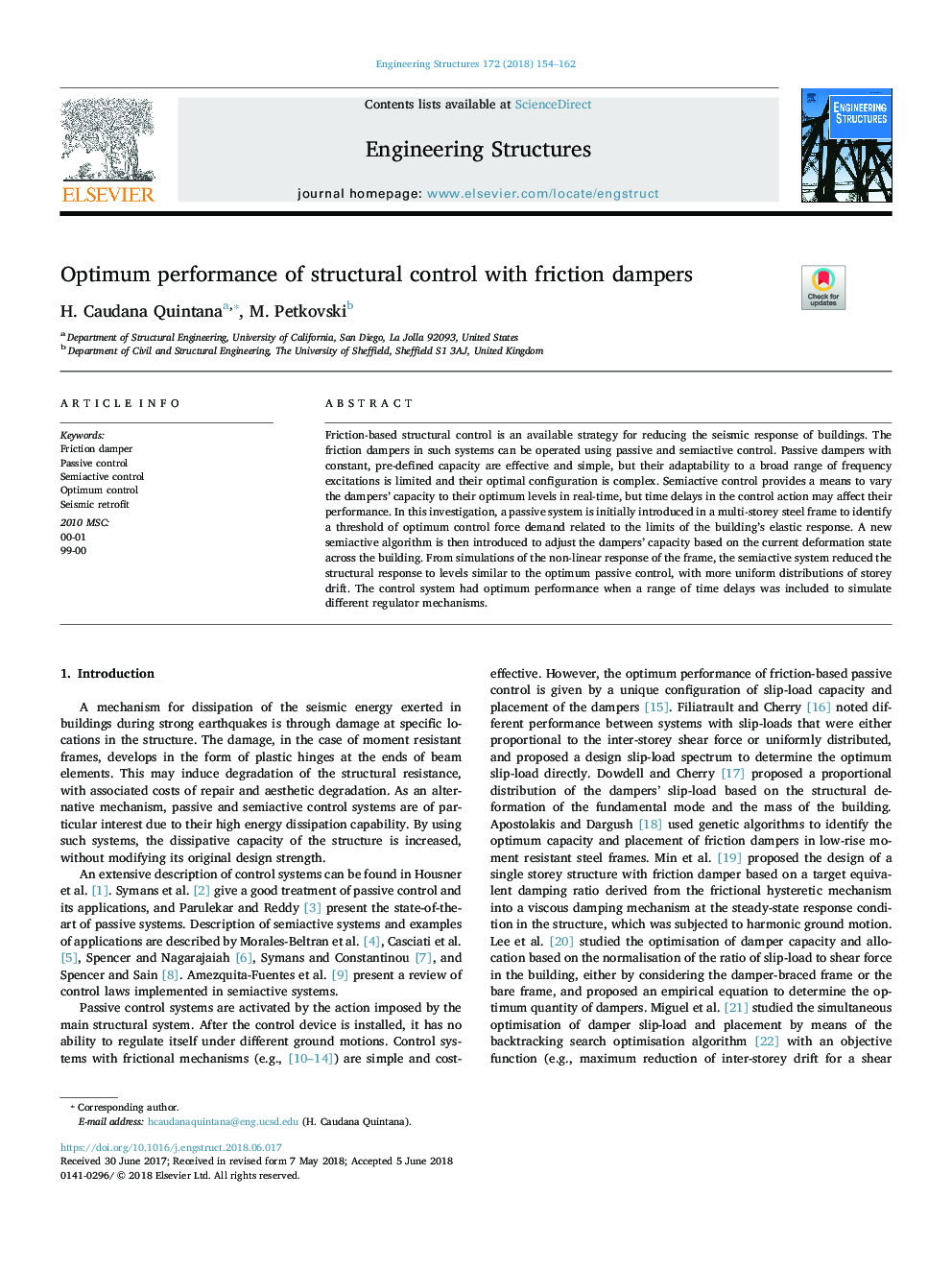| کد مقاله | کد نشریه | سال انتشار | مقاله انگلیسی | نسخه تمام متن |
|---|---|---|---|---|
| 6735919 | 1429055 | 2018 | 9 صفحه PDF | دانلود رایگان |
عنوان انگلیسی مقاله ISI
Optimum performance of structural control with friction dampers
ترجمه فارسی عنوان
عملکرد مطلوب کنترل ساختاری با دمپر اصطکاک
دانلود مقاله + سفارش ترجمه
دانلود مقاله ISI انگلیسی
رایگان برای ایرانیان
کلمات کلیدی
دمپر اصطکاک کنترل منفعل، کنترل نیمه هادی، کنترل بهینه، تکمیل لرزه ای، 00-01، 99-00،
ترجمه چکیده
کنترل ساختاری مبتنی بر اصطکاک یک استراتژی در دسترس برای کاهش پاسخ لرزه ای ساختمان ها است. سیستم های اصطکاک در چنین سیستم هایی می توانند با استفاده از کنترل منفعل و نیمه فعال عمل کنند. گیره های منفعل با ظرفیت ثابت با پیش تعیین شده موثر و ساده هستند، اما سازگاری آنها با طیف وسیعی از تحریک فرکانس محدود است و پیکربندی بهینه آنها پیچیده است. کنترل نیمه ابزاری می تواند وسیله ای برای تغییر ظرفیت دمپر به سطح مطلوب خود در زمان واقعی باشد، اما تاخیر زمانی در عمل کنترل ممکن است بر عملکرد آنها تاثیر بگذارد. در این تحقیق، یک سیستم منفعل در ابتدا در یک قاب فولادی چند طبقه ای معرفی شد تا آستانه ای از تقاضای نیروی کنترل بهینه را در ارتباط با محدودیت پاسخ الاستیکی ساختمان مشخص کند. سپس یک الگوریتم نیمه ابعادی جدید برای تنظیم ظرفیت دامپروری بر اساس وضعیت تغییر شکل فعلی در سراسر ساختمان معرفی شده است. از شبیه سازی پاسخ غیر خطی فریم، سیستم نیمه فعال پاسخ ساختاری را به سطوح شبیه به کنترل منفعل مطلوب، با توزیع یکنواخت رانش سطحی کاهش داد. سیستم کنترل عملکرد مطلوب را برای زمانی که طیف وسیعی از تاخیر زمان برای شبیه سازی مکانیزم های مختلف تنظیم کننده گنجانده شده بود.
موضوعات مرتبط
مهندسی و علوم پایه
علوم زمین و سیارات
مهندسی ژئوتکنیک و زمین شناسی مهندسی
چکیده انگلیسی
Friction-based structural control is an available strategy for reducing the seismic response of buildings. The friction dampers in such systems can be operated using passive and semiactive control. Passive dampers with constant, pre-defined capacity are effective and simple, but their adaptability to a broad range of frequency excitations is limited and their optimal configuration is complex. Semiactive control provides a means to vary the dampers' capacity to their optimum levels in real-time, but time delays in the control action may affect their performance. In this investigation, a passive system is initially introduced in a multi-storey steel frame to identify a threshold of optimum control force demand related to the limits of the building's elastic response. A new semiactive algorithm is then introduced to adjust the dampers' capacity based on the current deformation state across the building. From simulations of the non-linear response of the frame, the semiactive system reduced the structural response to levels similar to the optimum passive control, with more uniform distributions of storey drift. The control system had optimum performance when a range of time delays was included to simulate different regulator mechanisms.
ناشر
Database: Elsevier - ScienceDirect (ساینس دایرکت)
Journal: Engineering Structures - Volume 172, 1 October 2018, Pages 154-162
Journal: Engineering Structures - Volume 172, 1 October 2018, Pages 154-162
نویسندگان
H. Caudana Quintana, M. Petkovski,
